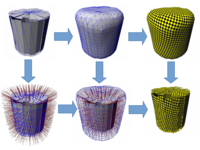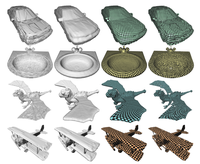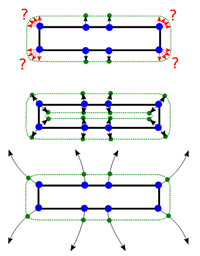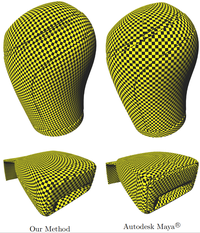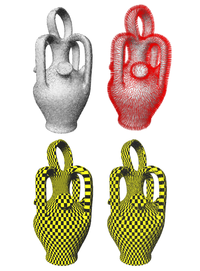Fast texture mapping for triangle soups using electrostatic monopole field lines
Published in: Computers & Graphics, Vol 77, pages 140-155, 2018
Abstract
We present an efficient approach for the parameterization of triangle soups. Our technique tackles the problem by first approximating the triangle soup by a watertight 2-manifold offset mesh proxy. By establishing point correspondences between the triangle soup and the shape proxy by tracing electrostatic field lines in time O(kn) instead of O(kn2), we can transfer properties computed on the surface, such as UV-coordinates even for large input meshes. The technique can process large triangle soups by replacing the computational intensive physical calculations by approximations developed initially for large-scale physical simulations. Thus, it is possible to decrease the time complexity of the initial charge distribution algorithm from O(n3) to O(n). We demonstrate our method on a multitude of challenging triangle soups and focus on the transfer of UV-coordinates during our experiments. An intensive run-time analysis and a comparison of our results to state of the art techniques in standard modeling tools concludes our study.
Keywords: Parameterization, Point Correspondences, Seamless Mapping, Texturing, Triangle Soups
Links:
[paper]¹
[paper (lowres images)]¹
[errata]
[bibtex]
[published in CAG]
[university page]
[DOI:10.1016/j.cag.2018.09.020]
Images
Bibtex
@ARTICLE{schier2018fast,
author = {Schier, Alexander and Hartmann, Stefan and Klein, Reinhard},
pages = {140--155},
title = {Fast texture mapping for triangle soups using electrostatic monopole field lines},
journal = {Computers {\&} Graphics},
volume = {77},
year = {2018},
keywords = {Parameterization, Point Correspondences, Seamless Mapping, Texturing, Triangle Soups},
abstract = {We present an efficient approach for the parameterization of triangle soups. Our technique tackles
the problem by first approximating the triangle soup by a watertight 2-manifold offset mesh proxy.
By establishing point correspondences between the triangle soup and the shape proxy by tracing
electrostatic field lines in time O(kn) instead of O(kn^2), we can transfer properties computed on
the surface, such as UV-coordinates even for large input meshes. The technique can process large
triangle soups by replacing the computational intensive physical calculations by approximations
developed initially for large-scale physical simulations. Thus, it is possible to decrease the time
complexity of the initial charge distribution algorithm from O(n^3) to O(n). We demonstrate our
method on a multitude of challenging triangle soups and focus on the transfer of UV-coordinates
during our experiments. An intensive run-time analysis and a comparison of our results to state of
the art techniques in standard modeling tools concludes our study.},
issn = {0097-8493},
url = {https://schier.info/papers/fast_texture_mapping.pdf},
doi = {https://doi.org/10.1016/j.cag.2018.09.020}
}
Errata
- The x-axis in Fig. 12 shows the number of field lines and not the number of triangles. In all our example models, the number of triangles is exactly twice the number of field lines, so the convergence rate is the same. The error is corrected in the interactive plots below.
- The denominator of the fraction in the definition of the potential φ in Eq. 1 and its discrete approximation Iij in section 7.4 should not be squared. The correct equations are:
and.
All results were computed using the correct formula.
